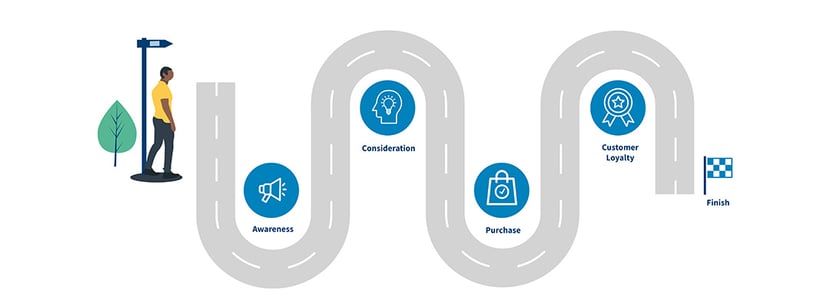When talking about improving customer service, one term that is often used is the customer journey. This journey has to be pleasant for your customers at all touchpoints in order to attract them, convince them, and retain them. Especially in the digital age – where everything is a service – it is important to know what to look out for, if you want the customer journey to meet the demands of your clients and prospects. Today we will discuss this term and how it is related to customer retention and customer loyalty.
What is the customer journey?
The customer journey is the figurative journey that customers embark on when they get in touch with your products and services. This journey is marked by different phases and touchpoints and while there is no completely uniform terminology, most visualizations show certain parallels, e.g. the awareness phase, the actual decision to purchase, contacts with customer service, all the way to open and voluntary advocacy for services based on high customer satisfaction.
A related term is the so-called customer experience. It includes everything that your (prospective) customers (as the name implies) experience at the different touchpoints of the customer journey. How do people become aware of your services? How do they first get in touch and how does that first contact go? Is the interface of your web shop easy to use? How friendly and helpful are your employees during a customer service encounter? These (and many more) questions paint a complex picture that ultimately determines whether you will be able to win new customers and whether they will remain loyal to you. But what do your customers expect from good service?

At the end of a successful customer journey is a happy customer who will recommend you to their peers
New demands towards the customer journey
The expectations of customers have transformed significantly during the past 10-20 years. These days, customers expect your service at all times, at any place, and ideally tailor-made for them on various channels (e.g. e-mail, phone, chatbots). Customer service should be fast, easy, and personal. Streaming services and on-demand offerings like Netflix, Amazon Prime and co. as well as website features like 24/7 chat services created a market where the availability of service anywhere, anytime is the standard. Additionally, the sheer amount of services available creates an environment, that makes it easy for customers to just switch service providers if they are not satisfied. How can you stop that from happening and increase customer retention?
Higher customer retention along the customer journey
Good news: If you want to effectively retain your new or potential customers – once they have been made aware of your service or product – you do not necessarily have to go above and beyond all expectations. Usually, successful customer service is less about delivering extraordinarily good service, but rather about avoiding negative experiences for your customers. The customer journey does not have to blow away anybody. Instead, is just has to go as smoothly as possible. Even the most well-oiled machine can at times have some loose screws, and your main job is “just” to offer what can reasonably be expected by your average customer. If your customer gets what they expect at each touchpoint of the customer journey without it being too much of a hassle, you have already overcome the biggest challenge of long-term customer loyalty. The working hypothesis is this: Your customers are by default loyal until things go wrong. But how do you make sure that you meet customer expectations?
Your toolkit for improving the customer journey
In general, there are three main touchpoints for customers along the digital customer journey – all of which can be supported by holistic knowledge management – that you need to cover: there is direct customer service (i.e. personal conversations on-site or over the phone), indirect customer service (i.e. via e-mail or chat) and there is self-service (i.e. opportunities for customers to autonomously solve problems themselves). Here is what you must keep in mind.
Direct customer service
Your customer service employees should not only be knowledgeable in their area of expertise, but furthermore possess the necessary social skills for customer communication. It is important to offer competent advice but – more often than not – it is key to meet the emotional needs of the person you are talking to. Professional advice needs to go hand in hand with empathy for particularly difficult problems and the ability to sooth the anger of annoyed or even furious customers. Additionally, if you have the capacity to offer customer service via videotelephony, you should use it to make customer service more personal and pleasant.

Good customer service is more than just being helpful on the phone
Indirect customer service
When it comes to e-mail and chat communication, response and resolution times are of particular importance. The faster your customer gets an answer to their query, the more valued and seen they will feel. If you offer multiple, easily accessible channels (e.g. specialized service apps, live chats, social media) that you can provide quick and helpful answers on, you are more than well-positioned.
Self-service
Today, many companies offer self-service portals that customers can use to find answers to their problems on their own. These portals are often powered by AI algorithms that ideally guide the customer intuitively and quickly towards the correct answers. However, self-service can be a double-edged sword: If somebody spends hours and hours in your FAQ section without finding helpful advice and then has to call the customer service after all, it can negatively impact their perception of your company. You have to make sure that your self-service offering meets the expectations of your customers.
The Customer Effort Score and other factors of digital customer service
Finally, there is the question of how you can measure customer loyalty for your organization. Here, the best key metric is the Customer Effort Score (CES). The CES measures the hassle that customers have to go through in order to resolve their issue. Compared to the often-used Net Promoter Score (NPS), the CES is better-suited to measure loyalty rather than mere customer satisfaction. A merely satisfied customers can decide for another service provider on a whim, but a loyal customer will stay with you even if you screw up sometimes. That is why the CES is such a good indicator of whether or not your customer service was fast, easy, and personal.
Is your customer service ready for the digital age?
Do you want to learn more about how to make your customer service ready for the digital age? Serviceware offers tailor-made software solutions and personal consulting to find the right way to optimize your customer service. Get in touch for an obligation-free consultation and get a free demo of our solutions.

 German
German

